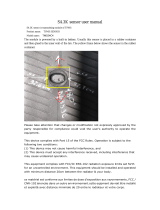La page est en cours de chargement...

User Guide of Cub 433 MHz Ball Sensor
FCC Statement
This device complies with part 15 of the FCC Rules. Operation is subject to
the following two conditions:
(1) This device may not cause harmful interference, and
(2) This device must accept any interference received, including interference
that may cause undesired operation.
NOTE: This equipment has been tested and found to comply with the limits for
a Class B digital device, pursuant to part 15 of the FCC Rules. These limits
are designed to provide reasonable protection against harmful interference in
a residential installation.
This equipment generates, uses and can radiate radio frequency energy
and, if not installed and used in accordance with the instructions, may cause
harmful interference to radio communications. However, there is no guarantee
that interference will not occur in a particular installation.
If this equipment does cause harmful interference to radio or television
reception, which can be determined by turning the equipment off and on, the
user is encouraged to try to correct the interference by one or more of the
following measures:
—Reorient or relocate the receiving antenna.
—Increase the separation between the equipment and receiver.
—Connect the equipment into an outlet on a circuit different from that to which
the receiver is connected.
—Consult the dealer or an experienced radio/TV technician for help.
Changes or modifications not expressly approved by the party responsible for
compliance could void the user’s authority to operate the equipment.
IC Statement

This device contains licence-exempt transmitter(s) that comply with
Innovation, Science and Economic Development Canada’s licence-exempt
RSS(s). Operation is subject to the following two conditions:
(1) this device may not cause interference,
(2) this device must accept any interference, including interference that may
cause undesired operation of the device.
L’émetteur exempt de licence contenu dans le présent appareil est
conforme aux CNR d’Innovation, Sciences et Développement économique
Canada applicables aux appareils radio exempts de licence. L’exploitation est
autorisée aux deux conditions suivantes :
1) L’appareil ne doit pas produire de brouillage;
2) L’appareil doit accepter tout brouillage radioélectrique subi, même si le
brouillage est susceptible d’en compromettre le fonctionnement.
Caution
1. This sensor is designed to be used in truck and bus tubeless tires
originally, and it also can be used in trailer vehicle, but forbidden using
it on passenger car.
2. The vehicle speed must not exceed 120 km/h (75 mph).
Installation
1. Dismount the tire from the rim. If applicable, take out any existing
TPMS sensors.
2. (433 MHz type) Before throwing the ball sensor into the tire, take note
of the sensor ID (printed on sensor surface) and do the manual ID
relearning (sensor ID paring) to the receiver, which ID learning is done
by key-in sensor ID. Alternatively, after throwing the sensor into the tire,
use the tire deflation method or trigger sensor by Cub specific tool to
IC Statement

relearn.
(For 2.4 GHz type) Use the Cub Retrofit truck tool to program the
correct wheel position ID to the sensor, then throw it into the
corresponding tire. Please check the user manual of the product kit to
know the relationship between wheel ID and tire location for different
types of vehicle.
3. Clean the surface of the wheel near the valve stem with isopropyl
alcohol and allow to dry completely. Write the wheel position ID with a
paint marker pen on the TPMS sticker label included with the ball
sensor. Adhere the sticker to the clean surface near the valve stem.
This will serve as an indicator that a sensor is present in the wheel and
of the wheel position ID.
Warranty
CUB warrants that the TPMS sensor shall be free from defects in
workmanship and material during warranty period. CUB does not assume any
liability in case of faulty, incorrect installation of the product, or by using other
products causing TPMS sensor malfunction on the part of customer or user.
www.cubelec.com.tw
5A268U00201-01
/
